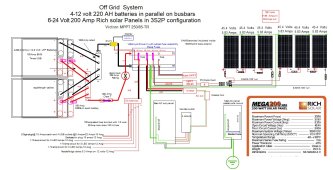I have a “farm panel” electrical setup where main power from the utility feeds the meter and a main breaker set on a pole in the yard. The house and barn are fed separately from this main panel. The house and barn each have a sub panel, with a main breaker.
The ground and neutral are bonded in the main farm panel, and are not bonded in the house or barn sub panels. The only ground rod is below the main farm panel.
I am working on a non grid tie system for the barn. Solar panels, 880 Amp hours capacity of 12 volt batteries, and 2000 watt inverter.
Beyond a few direct 12 volt accessory outlets, I want to feed a 4 circuit manual generator transfer switch from the inverter. Something similar to the switch shown, or a 30 Amp switch.
This would allow inverter feed, as well as generator feed (not at the same time).
The total load of the 4 circuits combined (all items on a circuit running at the same time) does not reach the 16.66 Amp maximum available power of the inverter. Max draw is in the 14 Amp range.
It is my wish to run general lighting circuits 24 hours a day using the solar/battery system (2 Circuits). This draw is around 6 Amps and is to be able to use/exercise the solar panels and system while keeping a hefty reserve. This would use roughly 85-90 Amp hours per 24 hour period.
The other 2 circuits would be available for running a fridge, furnace blower, etc. in a power outage.
I have on hand a Rich solar 2000 Watt pure sine wave inverter, with two outlets. The thought was to run a 10/2 cable from the inverter into a breaker box with 20 Amp breaker, then to the transfer switch (about 30’ away) in conduit where exposed, and install a plug and socket on the ends.
I have a #8 ground cable running from the #6 on the solar array, connected to the negative bus bar, inverter chassis ground, all other equipment grounds, and then to the ground bar in the barn’s AC panel.
The inverter does not have a wire connected to the ground terminal on the sockets. By grounding the inverter chassis to the main AC ground bar, am I safe with this system? There is no info in the owner’s manual, and Rich solar must be swamped as they haven’t responded.
The AC circuits I am connecting to in the AC panel have a typical ground, neutral, hot setup. When I transfer from AC to inverter, that neutral and ground, which is not connected in that sub panel, but in the farm panel, would then be “bonded”, because of the tie in with the inverters grounded chassis, right?
The ground and neutral are bonded in the main farm panel, and are not bonded in the house or barn sub panels. The only ground rod is below the main farm panel.
I am working on a non grid tie system for the barn. Solar panels, 880 Amp hours capacity of 12 volt batteries, and 2000 watt inverter.
Beyond a few direct 12 volt accessory outlets, I want to feed a 4 circuit manual generator transfer switch from the inverter. Something similar to the switch shown, or a 30 Amp switch.
This would allow inverter feed, as well as generator feed (not at the same time).
The total load of the 4 circuits combined (all items on a circuit running at the same time) does not reach the 16.66 Amp maximum available power of the inverter. Max draw is in the 14 Amp range.
It is my wish to run general lighting circuits 24 hours a day using the solar/battery system (2 Circuits). This draw is around 6 Amps and is to be able to use/exercise the solar panels and system while keeping a hefty reserve. This would use roughly 85-90 Amp hours per 24 hour period.
The other 2 circuits would be available for running a fridge, furnace blower, etc. in a power outage.
I have on hand a Rich solar 2000 Watt pure sine wave inverter, with two outlets. The thought was to run a 10/2 cable from the inverter into a breaker box with 20 Amp breaker, then to the transfer switch (about 30’ away) in conduit where exposed, and install a plug and socket on the ends.
I have a #8 ground cable running from the #6 on the solar array, connected to the negative bus bar, inverter chassis ground, all other equipment grounds, and then to the ground bar in the barn’s AC panel.
The inverter does not have a wire connected to the ground terminal on the sockets. By grounding the inverter chassis to the main AC ground bar, am I safe with this system? There is no info in the owner’s manual, and Rich solar must be swamped as they haven’t responded.
The AC circuits I am connecting to in the AC panel have a typical ground, neutral, hot setup. When I transfer from AC to inverter, that neutral and ground, which is not connected in that sub panel, but in the farm panel, would then be “bonded”, because of the tie in with the inverters grounded chassis, right?




